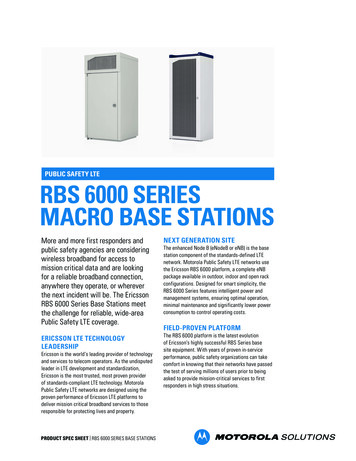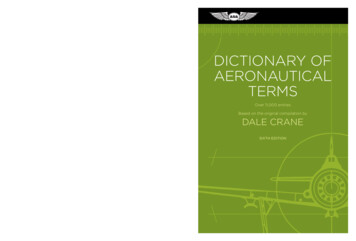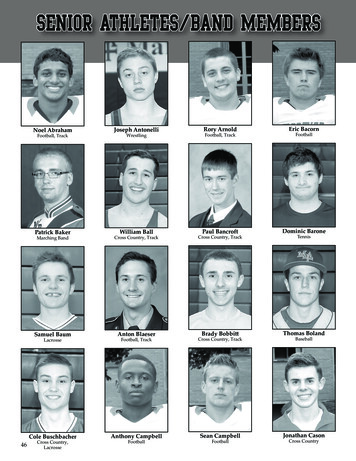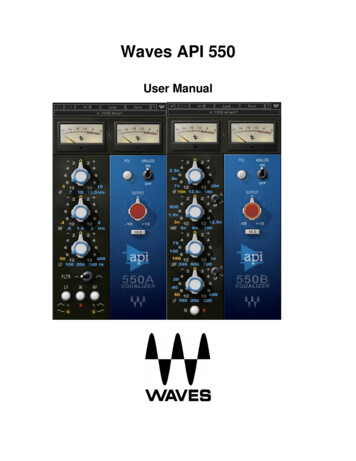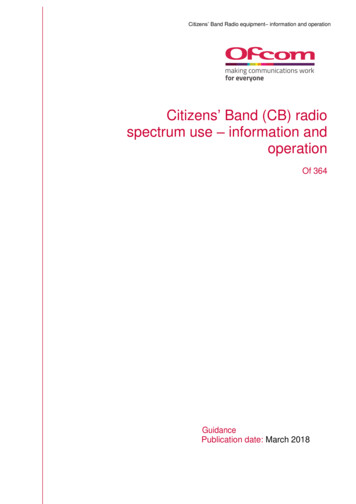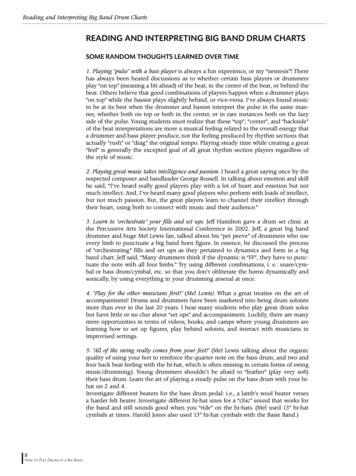
Transcription
L-BAND DIGITAL AERONAUTICAL COMMUNICATIONS SYSTEM (LDACS)ACTIVITIES IN SESAR2020C. Rihacek, B. Haindl, Frequentis AG, Vienna, AustriaP. Fantappie, S. Pierattelli, Leonardo S.p.a., ItalyT. Gräupl, M. Schnell, German Aerospace Center, Oberpfaffenhofen, GermanyN. Fistas, EUROCONTROL, Brussels, BelgiumAbstractAir traffic management communication shalltransition from analog VHF voice communication tomore spectrum efficient digital data communication.In Europe this transition shall be realized, amongothers, by the development and implementation ofthe L-band Digital Aeronautical CommunicationsSystem (LDACS). The objective of this paper is toprovide a status report on the current progress ofLDACS research and development withinSESAR2020. In particular, we present the objectivesof SESAR2020 project "PJ.14-02-01 FCI TerrestrialData Link", the proposed LDACS high-levelarchitecture, the planned technical validationexercises, and the status of the ongoing LDACSstandardization activities: The objective of theSESAR2020 project is to develop fully functionalLDACS prototypes and to use them for validation ofthe air interface requirements and the support of theATN IPS infrastructure. The LDACS architecture hasbeen defined as a complete set of network functionsneeded to provide radio access to an LDACSsubscriber i.e. an aircraft. LDACS standardization iscurrently under way in ICAO and is planned to startin EUROCAE later this year.IntroductionOne of the main pillars of the modern air trafficmanagement (ATM) system is the existence of acommunication infrastructure that enables efficientaircraft guidance and safe separation in all phases offlight. Although current systems are technicallymature, they are suffering from the VHF band’sincreasing saturation in high density areas. Therefore,aviation globally and in the European Union (EU) inparticular, strives for a sustainable modernization ofthe aeronautical communication infrastructure.In the long-term, ATM communication shalltransition from analog VHF voice and VDL2communication to more spectrum efficient digitaldata communication. The European ATM MasterPlan [1] foresees this transition to be realized, amongothers, by the development and implementation ofthe L-band Digital Aeronautical CommunicationsSystem (LDACS). It is important to highlight thatLDACS is one of the three new and key componentsof the Future Communications Infrastructure (FCI),which foresees the coordinated use of legacy and newtechnologies (LDACS, AeroMACS and NewSATCOM) to meet the future communicationrequirements and support B2 and B3 ATS services.The development of LDACS has already madesubstantial progress in the Single European Sky ATMResearch (SESAR) framework, and is currently beingcontinued in the follow-up program, SESAR2020. Akey objective of the SESAR activities is to develop,implement and validate a modern aeronautical datalink able to evolve with aviation needs over the longterm. To this end, an LDACS specification has beenproduced [2] and is currently updated; transmitterdemonstrators were developed to test the spectrumcompatibility of LDACS with legacy systemsoperating in the L-band [3]; and the overall systemperformance was analyzed by computer simulations,indicating that LDACS can fulfil the identifiedrequirements. In addition, LDACS standardizationwithin the ICAO framework started in December2016. The ICAO standardization group is workingclosely together with SESAR and is aiming at havinginitial Standards and Recommended Practices(SARPs) ready by end of this year (2018).The objective of this paper is to provide a statusreport on the current progress of LDACS researchand development within SESAR2020. In particular,we present the objectives of SESAR2020 project"PJ.14-02-01 FCI Terrestrial Data Link", theproposed LDACS high-level architecture, theplanned technical validation exercises, and the statusof the LDACS standardization activities.978-1-5386-5679-2/18/ 31.00 2018 IEEE4A1-1
BackgroundCommunications, Navigation and Surveillance(CNS) systems provide the invisible and oftenunappreciated infrastructure which is essential for airtraffic management. CNS enables efficient navigationand safe separation in all phases of flight. TheSESAR concept of operations aims to dramaticallyincrease the exchange of information betweenairspace users, air traffic control and flowmanagement. This is expected to improve the qualityof service to the travelling public, whilst reducingcost and environmental impact. Although currentCNS systems are mature and generally providing agood service, they have not yet fully transitionedfrom analog to digital technologies. Such a shift isneeded to meet the challenges of the coming years; toaccommodate higher levels of traffic and improveoperational efficiency.SESAR2020Building on the experience gained in the firstphase of SESAR (SESAR1), SESAR2020 willdevelop an integrated suite of CNS solutions to meetthe operational requirements of the ATM system inthe short, medium and long term, with technologiesthat are consistent with the European ATM MasterPlan and the ICAO Global Air Navigation Plan [4].SESAR2020 developments are based on fourKey Features, as described in the European ATMMaster Plan: Optimized ATM Network servicesAdvanced air traffic servicesHigh-Performing airport operationsEnabling aviation infrastructureProject 14 "PJ14 Essential and EfficientCommunication Navigation and SurveillanceIntegrated System" (EECNS), as one of the enablingprojects within SESAR2020, aims at providingadvanced, integrated and rationalized aviationinfrastructure for CNS, supporting the first three KeyFeatures, and providing the underlying technicalcapabilities to meet the operational improvements.SESAR2020 ProjectTerrestrial Data Link"PJ.14-02-01"FCIThe more stringent ATM performancerequirements, due to the change of ATM to a 4Dtrajectory based concept, raises the need to introducean appropriate data link solution to support the airtraffic services evolution according to the ICAOtechnology roadmaps and the ATM key improvementareas of SESAR. In particular, the 4D trajectorymanagement operational concept needs to besupported by a reliable, scalable, modular andefficient data link technology.Within SESAR PJ14 the (sub-)project 1 PJ.1402-01 "FCI Future Terrestrial Data Link" has theobjective to develop and standardize the candidatefuture terrestrial data link system LDACS. The goalof PJ.14-02-01 is to progress with the developmentand validation of the LDACS technology. Thisincludes security and digital voice concepts, and willcontribute to the development of a harmonized globalstandard. To achieve these, the project will developand verify a fully functional LDACS prototype andassess the impact on other systems. The prototypewill support ATS B2 applications using the ATN/IPSprotocols.Objectives of SESAR2020 Project PJ.14-02-01"FCI Terrestrial Data Link"The definition of the future terrestrial data linkLDACS 2 is based on the work already performed onLDACS in SESAR1 3 and is aligned withinternational standardisation activities. The activitiesplanned in PJ.14-02-01 include technical validations(leading to publication of specifications) as well tative applications.The project plans to provide a direct benefit tothe SESAR2020 performance targets by thefollowing objectives: Making progress with the standardizationof the LDACS technology.1SESAR2020 refers to sub-projects with the term "solution".Background information on LDACS can be found in AppendixA.3Note that LDACS was called LDACS1 in SESAR1.24A1-2
Development of the LDACS systemarchitecture and finalization of thedevelopment of the LDACS air-grounddatalink. Development and validation of fullyfunctional LDACS prototypes.The status of each of these objectives ispresented in the following sections.Status of the LDACS StandardizationActivitiesCurrently, there are no standards and regulationsfor LDACS available. In general, various standardswill need to be developed from differentstandardization organizations, as prerequisite for theLDACS implementation and deployment. Thesestandards need to cover the frequency aspects (signalin space and interference), performance avionics, etc.It is an objective of PJ.14-02-01 to support thedevelopment of LDACS standards.Considering the currently deployed systems,LDACS standards are expected to be delivered fromICAO, EUROCAE/RTCA, AEEC. In addition, ETSImay also cover LDACS and if in the future there willbe a regulation associated with an LDACSdeployment in Europe, regulatory standards (i.e.,Implementing Rules) may also be required to bedeveloped by the European Commission.The following paragraphs summarize thedocuments that each organization may produce andthe current status focusing at this stage in ICAO,EUROCAE and AEEC.The Project Team „Terrestrial Data Link”(PT-T) of the ICAO Communications Panel (CP)expects to develop initial standards by the end of2018, and initial technical guidance material(Manual) by 2020. The final LDACS SARPS areplanned for 2026.EUROCAE is expected to publish LDACSMOPS to cover the equipment functionality. Inaddition, a MASPS may also be required to cover theoverall system aspects including performance. Theinvolvement of RTCA is desired and a joint activitywill be pursued if agreed. EUROCAE together withRTCA have already developed performance anddescription documents (SPR, OSED) for B2 servicesand it is expected that they will also develop suchdocuments for the future, more stringent services(B3). The initiation of an LDACS standardizationactivity in EUROCAE has been discussed and aEUROCAE group to support this is already identified(Working Group 82). However, it has been decidedto progress first the standardization work in ICAObefore initiating activities in EUROCAE. It isexpected that EUROCAE will kick-off LDACSstandardization activities at the end of 2018considering also the progress in ICAO.AEEC is expected to develop the ARINCavionics standards covering the Form Fit andFunction (FFF) aspects of the LDACS avionics boxand facilitate the LDACS integration on the aircraft.There have been briefings about LDACS to AEECand LDACS is identified as a future developmentactivity. Currently it is considered too early to initiatean activity in AEEC. Thus such activity for anARINC avionics standard will be proposed tocommence at a later stage when the ICAO andEUROACE standards will have progressedsufficiently.Status of the LDACS DevelopmentActivitiesLDACS is the technology considered anddeveloped as ground-based part of the FutureCommunications Infrastructure to support futureaeronautical requirements for data communications.Choosing the L-band (960-1164 MHz) for deployingan En-Route terrestrial (long range) communicationtechnology is explained by the lack of suitablefrequency bands, as the other two aviation bands areeither not available (VHF band is already racteristics of C-band). The L-band which isalready extensively used by aviation has beenallocated to the Aeronautical Radio NavigationService for many years. It has also been available forAeronautical Mobile Route Service since WorldRadio Conference (WRC) 2007.LDACS provides high performance by usingbandwidth resources more efficiently than existingterrestrial aeronautical datalinks and is welldimensioned to cope with the expected future trafficgrowth. However as LDACS needs to coexist in theconsidered band with other legacy aviation systems(such as DME in particular) significant effort isrequired to demonstrate the compatibility with the4A1-3
connectivity between an LDACS airborne station anda LDACS ground station (GS), (2) transfer of AAAmessages to LDACS subscriber’s home networkservice provider for authentication, authorization andsession accounting for subscriber sessions, (3)network discovery and selection of the LDACSsubscriber’s preferred network service provider (i.e.IP address allocation) and relay functionality forestablishing layer 3 connectivity, and (4) radioresource management. In addition to the abovemandatory functions, for a portable and mobileenvironment, a ground-station controller (GSC) shallsupport LDAN anchored mobility, a location register,and interface with an Authentication, Authorization,and Accounting (AAA) server.affected systems and this is an important task thatneeds to be completed.The development of LDACS in SESAR2020 isbased on previous work performed in recent years:An LDACS specification has been produced [2] andhas already been updated; transmitter demonstratorswere developed to test the spectrum compatibility ofLDACS with existing systems operating in the Lband [3]; and the overall system performance wasanalyzed by computer simulations, indicating thatLDACS can fulfil the identified requirements.On the basis of these results the development ofLDACS is continued in SESAR2020 project PJ.1402-01.The LDAN comprises network elements such asone or more Ground Stations, and a Ground-StationController. An LDAN may be shared by more thanone communication service provider networks. Thehigh-level architecture of the LDACS access networkis illustrated in Figure 1.LDACS High-Level ArchitectureThe LDACS Access Service Network (LDAN)is defined as a complete set of network functionsneeded to provide radio access to an LDACSsubscriber i.e. an aircraft. The LDAN provides thefollowing mandatory functions: (1) LDACSR2AAAG3Airborne VoiceManagement systemPossible longterm VoIPinterfaceA3LDACS AVI(Airborne VoiceInterface)G5A0G1A/G-RLDACS GSATN/IPS AirborneRouterATN/OSI AirborneRouterACARS AirborneRouterA2-aLDACS ARAC-RR1G2A2-bGSCG1LDACS ANIA2-cLDACS Airborne RadioLDACS Airborne Nework IFLDACS Ground StationLDACS Ground Station ControllerLDACS Access NetworkR1:R2:A1:A2-x:G1:G2:G3:G4:G5:G6EG1LDACS A/G InterfaceLDACS AAALDACS RRExternal LDACS IF to Mobile SNCntrol and data IF between the GS and the GSCGS to GS IF to coordinate AS mobilityGSC to AAA IF for authenticationCoordinate Mobility between GSCGSC to A/G IFGSC to OSI Router IFExternal LDACS IF to Ground IPS to manage A/Gdata communicationExternal LDACS IF to Ground IPS to manageVoIP A/G comunicationEG2:EG2VoIPED137ATN OSIOSIRouterLDAN#1LDACS MS G4LDACS ARLDACS ANILDACS GSGSCLDANGroundIPSEG3G6LDACS GSA1EG1Ground IPS NetworkG1LDACS GSAC-RGSCG2G1LDACS GSLDAN#nFigure 1. LDACS System Reference Model, Including the LDAN and the LDACS Airborne Subsystem4A1-4
The LDACS ground network reference modelcomprises three entities: Ground-stations, the groundstation controller, the AAA server, and the access andA/G router.Reference point G1 consists of the set of controland user plane protocols for communication betweenthe ground-station and the ground-station controller.The bearer plane consists of intra-LDAN data pathbetween the ground-station and ground-stationcontroller. The control plane includes protocols fordata path establishment, modification, and releasecontrol in accordance with the aircraft mobilityevents.Reference Point G2 consists of the set of controlplane protocols originating/terminating in groundstation of an LDAN that coordinate aircraft mobilitybetween ground-stations.Reference Point G3 is a physical connection andconsists of protocols and procedures between AAAserver and GSC associated with serviceauthentication, authorization, and accountingmanagement.Reference Point R1 consists of the protocols andprocedures between an aircraft and a ground-stationas part of the LDACS air interface (physical layerand medium access layer).The LDACS airborne reference modelcomprises three modules: the airborne radio (AR),the airborne network interface (ANI), and theairborne voice interface.Reference point A1 consists of the set ofprotocol message that manage the connectionbetween ANI and AR.Reference point A2-a consists of the set ofcontrol and user protocols that manage ATN-IPSairborne router communication. Reference point A2b consists of the set of control and user protocols thatmaymanageATN-OSIairborneroutercommunication. Reference point A2-c consists of theset of control and user protocols that may manageACARS airborne router communication.Reference point A3 consists of the set of controland user protocols that manages the connection to theairborne voice management system.LDACS Air-Ground DatalinkPJ.14-02-01 is currently working on an updateof the LDACS specification [2]. Several internalversions were produced and reviewed within thescope of SESAR and were also discussed in ICAOmeetings. A first version of the LDACS specificationupdate has been submitted to SESAR in December2017. Following this version and in preparation of thesecond version (planned for July 2019), furtherinternal drafts will be produced. The deliverableD3.3.010 "LDACS A/G Specification" of PJ.14-0201 shall then provide the basis for the LDACSmanual to be published by ICAO.LDACS PrototypesProject PJ.14-02-01 will develop and verify fullyfunctional LDACS prototypes in order to validate theair interface requirements and to support thevalidation of ATN IPS infrastructure.It is planned to execute three different kinds oftechnical validation exercises. The first type ofexercises aims to verify the conformity of theimplementation with the existing LDACSspecification and should reveal issues in thespecification that should be revised when progressingwith the LDACS standard. The objective of thesecond exercise is to interconnect LDACStransmitters and receivers implemented by differentProject PJ.14-02-01 members to prove theinteroperability of the implemented prototypes and toidentify any ambiguity of the LDACS specification.The results of this validation exercise will be used tospecify these requirements in the LDACSspecification more precise. The third exerciseinvolves two LDACS ground stations and oneLDACS airborne station (AS). It aims to demonstrateLDACS’ mobility support, including the exchange ofLDACS A/G mobility management informationduring the hand-over of an LDACS AS betweendifferent GSs. The results from the third validationexercise will be used to verify the proposed mobilitysolution and assess the impact on LDACS as well asto verify the support of ATS B2 applications usingthe ATN/IPS ground network.Planned Technical Validation ExercisesIn order to reach the planned maturity level(TRL4 "technology validated in lab") three different4A1-5
kinds of technical validation activities are planned tobe performed.LDACS conformance testing: This activityvalidates the conformance of the RF front-end andphysical layer conformance (transmitter and receiver)with regard to the LDACS specification and theLDACS ranging concept.LDACS interoperability testing: This activityvalidates the interoperability of different LDACSprototypes, manufactured by different vendors, overthe air interface.LDACS end-to-end testing: This activityvalidates the interoperability of LDACS airborne andground prototypes with ATN/IPS ground network, asrequired for end-to-end testing. It verifies data linkcapabilities for air traffic services using ATN/IPSincluding the verification of airborne and ground IPinterfaces. The activity also validates the LDACSmobility support, including the LDACS – A/Gmobility management information exchange duringLDACS airborne handoff.Future WorkWhile significant progress is expected to beachieved in the context of PJ14-02-01, further workwill be required particularly in the area of spectrumcompatibility and support to validation andstandardization. The SESAR2020 frameworkforesees that current activities (wave 1) will becompleted in 2019 and new activities (wave 2) willbe defined to continue the required work (2020 andbeyond.),ConclusionThe objective of this paper was to provide astatus report on the current progress of LDACSresearch and development within al Data Link" is currently developing fullyfunctional LDACS prototypes to validate the airinterface requirements and to support the validationof ATN IPS infrastructure. In addition, the projectwill produce an LDACS architecture and support thestandardizationofthesystem.LDACSstandardization has started in the context of ICAO.References[1] SESAR, “European ATM Master w.atmmasterplan.eu.[2] M. Sajatovic, B. Haindl, U. Epple, T. Gräupl, C.Rihacek, M. Schnell, N. Fistas, J.-U. Koch, H.-W.Kim, and E. Le-Ho, “EWA04-1-T2-D1 UpdatedLDACS1 System Specification,” Brussels, Belgium,2011.[3] M. Sajatovic, H. Günzel, and S. Müller, “WA04D22 Test Report for Assessing LDACS1 TransmitterImpact upon DME/TACAN Receivers,” Brussels,Belgium, 2014.[4] ICAO, “Global Air Navigation Plan .pdf.[5] M. Schnell, U. Epple, D. Shutin, and N.Schneckenburger, “LDACS: Future AeronauticalCommunications for Air-Traffic Management,”Commun. Mag. IEEE, vol. 52, no. 5, pp. 104–110,2014.[6] S. Brandes, U. Epple, S. Gligorevic, M. Schnell,B. Haindl, and M. Sajatovic, “Physical LayerSpecification of the L-band Digital ceedings of the 2009 Integrated Communications,Navigation and Surveillance Conference, ICNS 2009,2009.[7] T. Gräupl and M. Ehammer, “LDACS1 DataLink Layer Evolution for ATN/IPS,” in AIAA/IEEEDigital Avionics Systems Conference - Proceedings,2011.[8] S. Ayaz, F. Hoffmann, U. Epple, R. German,and F. Dressler, “Performance Evaluation of NetworkMobility Handover Over Future Aeronautical DataLink,” Comput. Commun., vol. 35, no. 3, pp. 334–343, 2012.[9] N. Franzen, A. Arkhipov, and M. Schnell, “LDACS1 Physical Layer Laboratory Demonstrator,” in2010 Integrated Communications, Navigation, andSurveillance Conference Proceedings, ICNS 2010,2010.[10] N. Fistas and M. Schnell, “ICAO AeronauticalCommunications Panel (ACP) Fourth Meeting of the4A1-6
Working Group of the Whole: LDACS1 PhysicalLayer Laboratory Demonstrator,” 2011.Appendix A: Background on LDACSAircraft thus transmit discontinuously on the reverselink with radio bursts sent in precisely definedtransmission opportunities allocated by the ations System (LDACS) is a broadbandair-ground datalink proposed to supplement the VHFcommunication infrastructure in the L-band [5]. It isdesigned to provide air-ground data communicationwith optional support for digital voice. It is a cellularbroadband system based on Orthogonal FrequencyDivision Multiplexing (OFDM) technology [6] andsupports quality-of-service taking the requirements ofaeronautical services into account. It shares manytechnical features with 3G and 4G wirelesscommunications systems.The data-link layer provides the necessaryprotocols to facilitate concurrent and reliable datatransfer for multiple users. The LDACS data linklayer is organized in two sub-layers: The mediumaccess sub-layer and the logical link control sublayer. The medium access sub-layer manages theorganization of transmission opportunities in slots oftime and frequency. The logical link control sublayer provides reliable and acknowledged point-topoint logical channels between the aircraft and theground-station using an automatic repeat requestprotocol.Computer simulations have assessed theexpected performance of LDACS. Multipleindependent simulation campaigns were conductedby Gräupl et al. [7], , and Ayaz et al. [8] predictingsimilar performance figures. Partial prototypeimplementations in hardware have also been prepared[9] [10].In depth information on LDACS is available atwww.ldacs.com.LDACS will be one of several wireless accessnetworks connecting aircraft to the aeronauticaltelecommunications network. The LDACS accessnetwork contains several ground stations, each ofthem providing one LDACS radio cell.The LDACS air interface is a cellular datalinkwith a star-topology connecting aircraft to groundstations with a full duplex radio link. Each groundstation is the centralized instance controlling all airground communications within its radio cell.The LDACS air interface protocol stack definestwo layers, the physical layer and the data link layer.The physical layer provides the means totransfer data over the radio channel. The LDACSground-station supports bi-directional links tomultiple aircraft under its control. The forward linkdirection (FL; ground-to-air) and the reverse linkdirection (RL; air-to-ground) are separated byfrequency division duplex. Forward link and reverselink use a 500 kHz channel each. The ground-stationtransmits a continuous stream of OFDM symbols onthe forward link. In the reverse link different aircraftare separated in time and frequency using acombination of orthogonal frequency-divisionmultiple-access and time-division multiple-access.Acronyms and orization,AeroMACS AeronauticalMobileCommunication SystemandEngineeringAirportARINCAeronautical Radio, IncorporatedASAirborne StationATMAir Traffic ManagementATNAeronauticalNetworkATN/IPSATN using IPSCNSCommunication,SurveillanceCPCommunications PanelCSCommunity SpecificationDLS – IRDatalink Services Implementing RuleEECNSEssential and Efficient CommunicationNavigation and Surveillance IntegratedSystem4A1-7TelecommunicationsNavigation,
ETSIEuropeanTelecommunicationsStandards InstituteEUEuropean UnionEUROCAEEuropean OrganizationAviation EquipmentFCIFuture Communications InfrastructureFFFForm, Fit, and FunctionGSGround-StationGSCGround-Station ControllerICAOInternationalOrganizationIPSInternet Protocol SuiteLDACSL-bandDigitalAeronauticalCommunication SystemLDACS1L-bandDigitalAeronauticalCommunication System type 1LDANLDACS Access Service NetworkMASPSMinimumAviationPerformance SpecificationMOPSMinimum Operational PerformanceSpecificationOSEDOperational Services and EnvironmentDefinitionPTProject TeamRTCARadio TechnicalAeronauticsSARPsStandards and Recommended PracticesSESARSingle European Sky ATM ResearchSPRSafety and Performance RequirementsVDL2VHF Digital Link mode 2VHFVery High FrequencyVoIPVoice over IPWRCWorld Radio ConferenceCivilforCivilThis solution, being part of PJ14 “Essential andEfficientCommunicationNavigationandSurveillance Integrated System – EECNS”, hasreceived funding from the SESAR Joint Undertakingunder grant agreement No 734168 under EuropeanUnion’s Horizon 2020 research and claimerOpinions expressed in this work reflect theauthors' views only and do not necessarily reflect theviews or positions of the organizations they belongto.4A1-82018 Integrated Communications Navigationand Surveillance (ICNS) ConferenceApril 10-12, 2018
the aeronautical communication infrastructure. In the longterm, ATM - communication shall transition from analog voice and VDL2 VHF communication tomore spectrum efficient digital data communication.The European ATM Master Plan [1] foresees this transition to be realized, among others, by the development and implementation of
